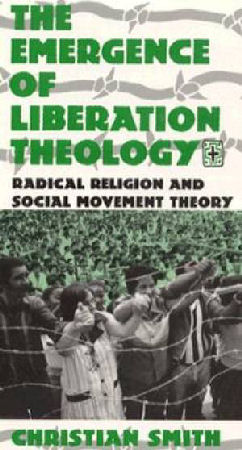
|
Posted June 5, 2008
Book: The Emergence of Liberation Theology: Radical Religion and Social Movement Theory Author: Christian Smith University of Chicago Press. Chicago, IL. 2008. Pp. 300 An Excerpt from the Jacket:
In this book, Christian Smith explains how and why the liberation theology movement emerged and succeeded when and where it did. He uses interviews, texts, historical documents and statistics, culled from research conducted in North America, England, Central and South America, to create the first comprehensive social history of the movement from 1930 to the present. Using the political process model — a theory explaining the emergence of social movements — Smith analyses the complex of social, political, organizational, and ideological forces and events which generated and sustain liberation theology. An Excerpt from the Book: Grass-roots social movements of the powerless and excluded have received considerable attention from sociologists. But liberation theology represents a different kind of social movement: a revitalization movement. We have seen that before the liberation theology movement was able to become a mass-based movement of excluded peasants and workers, the movement’s leaders had to gain control over the Church’s institutional authority and resources through a task logically akin to an organizational takeover. Before it could mobilize its members to exert pressure to transform society, it had to institutionalize its ideology and action strategy in the Church. And this first, critical step of the movement was carried out not by powerless, excluded masses using non-conventional means, but by theological elites in the context of a powerful, well-established organization using largely institutionalized means. Hence, the liberation theology movement should be understood as one of many elite-initiated revitalization movements that aim to force drastic redirections in the strategies and resources of established institutions. Other examples of revitalization movements that come to mind are Jesse Jackson’s “Rainbow Coalition” within the Democratic party, the collective action of scientists in political groups such as the Union of Concerned Scientists, and Mikhail Gorbachev’s program of perestroika and glasnost within the Communist party of Soviet Union. These revitalization movements are often very interesting, important types of social movements. Yet they are largely unexamined in the literature on social movements. The case of liberation theology examined here has offered one opportunity to correct that imbalance. Table of Contents: Part One: Understanding the liberation theology movement 1. A brief history of the liberation theology movement 2. What is liberation theology 3. Theoretical tools for analysis Part Two: The emergence of a movement 4. The historical context: 1930-1955 5. From the creation of CELAM to Vatican II: 1955-1965 6. From Vatican II to Medellin: 1965-1968 7. Making Medellin 8. From Medellin to Sucre: 1968-1972 9. From Sucre to Puebla: 1972-1979 10. Liberation theology since Puebla |
|
